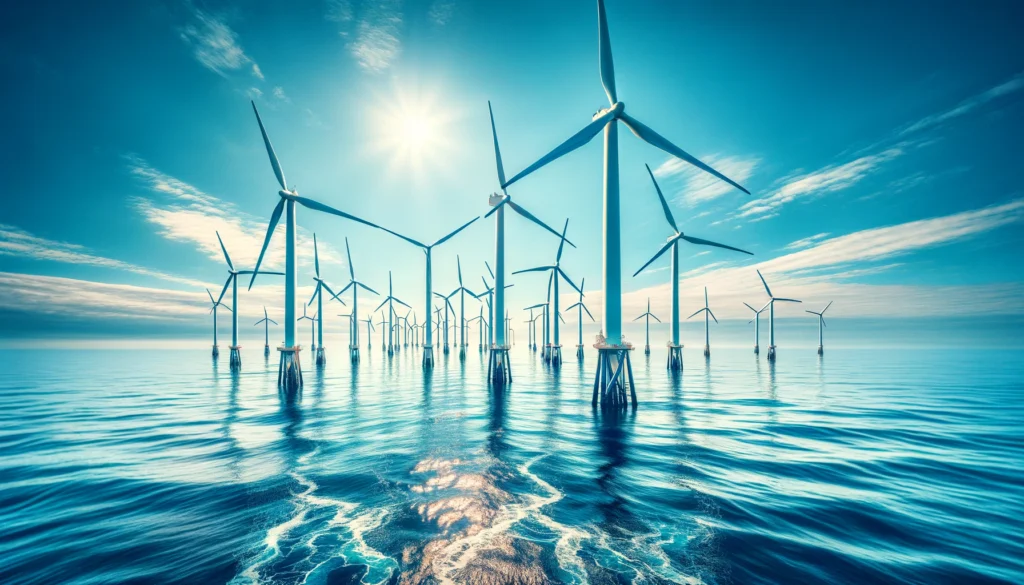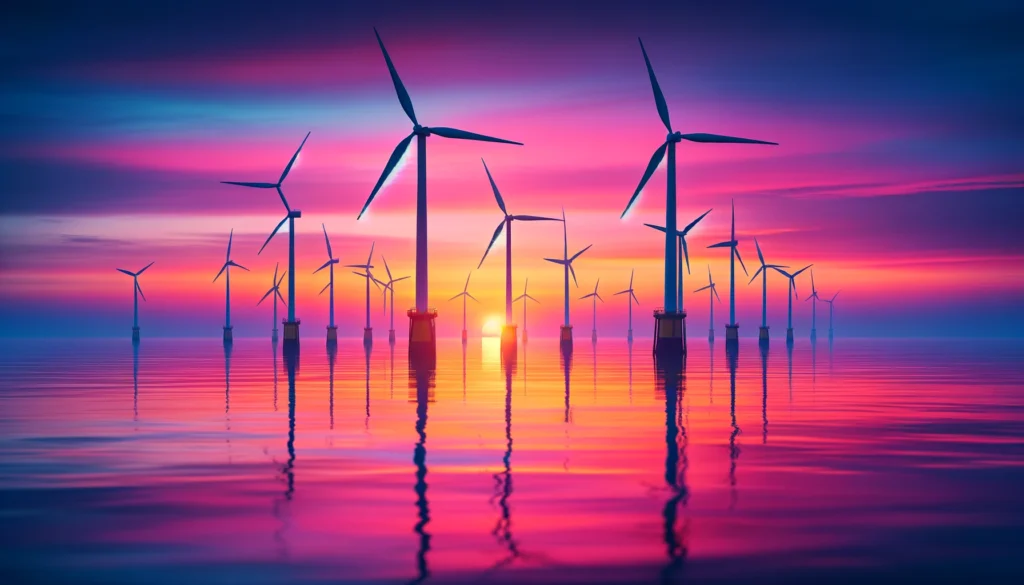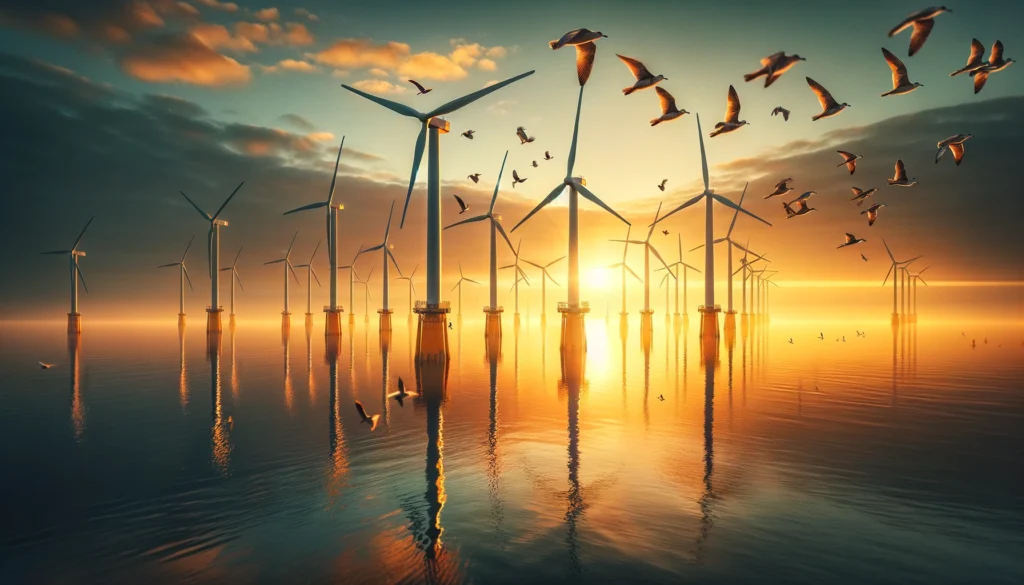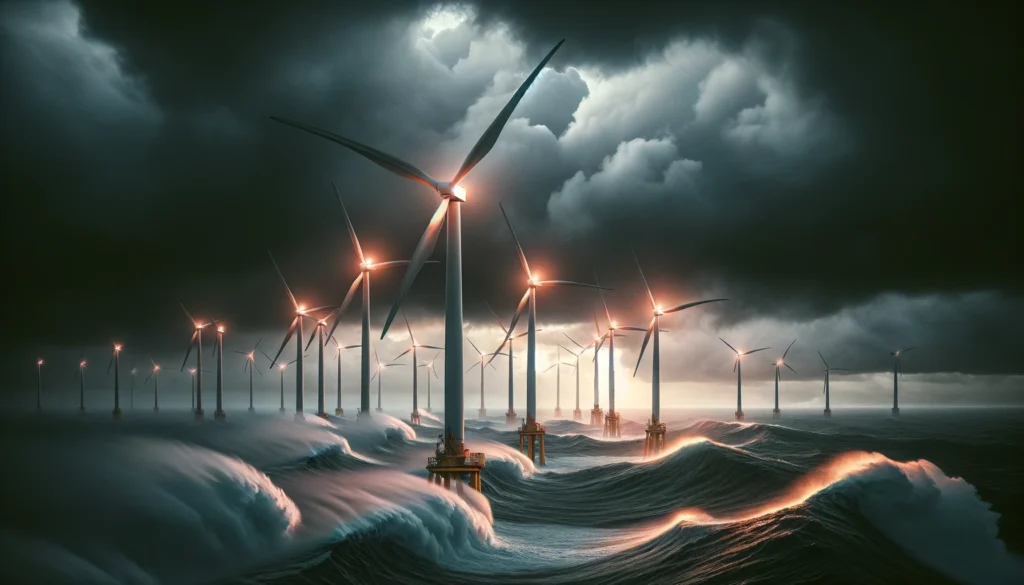In a world grappling with the challenges of climate change and depleting fossil fuel reserves, the quest for sustainable energy sources has become imperative. Offshore wind turbines have emerged as a promising solution, harnessing the power of wind over the vast expanses of the ocean to generate clean electricity. This article explores the burgeoning industry of offshore wind energy, its advantages, challenges, and its role in meeting global energy needs sustainably.
Table Of Content
We invite you to read: “Economic and Environmental Impacts of Offshore Wind Turbines”

Understanding Offshore Wind Energy
Offshore wind energy involves the installation of wind turbines in bodies of water, typically oceans and seas. These turbines are strategically positioned to capture the strong, consistent winds blowing over the water surface. As the wind turns the turbine blades, they drive a generator to produce electricity, which is then transmitted via underwater cables to the shore.
Advantages of Offshore Wind Turbines
- Abundant Resource: The oceans cover about 71% of the Earth’s surface and are characterized by strong and consistent wind patterns, offering a vast and reliable source of energy.
- Higher Wind Speeds: Wind speeds tend to be higher and more consistent offshore compared to onshore locations, leading to increased energy production potential.
- Reduced Visual Impact: Offshore wind farms are typically located far from populated areas, minimizing visual and noise impacts on communities.
- Space Utilization: By utilizing offshore space, these turbines avoid competing for land resources needed for agriculture, urban development, or conservation.
- Energy Security: Diversifying energy sources with offshore wind reduces dependence on finite fossil fuels, enhancing energy security and resilience.
Technological Advances in Offshore Wind
- Floating Turbines: Traditional offshore wind turbines are fixed to the seabed, but floating turbines are gaining traction, allowing deployment in deeper waters where seabed foundations are not feasible.
- Increased Capacity and Efficiency: Advances in turbine design and engineering have led to larger and more efficient turbines capable of capturing more wind energy and generating higher outputs.
- Remote Monitoring and Maintenance: Technological innovations enable remote monitoring and predictive maintenance, reducing operational downtime and costs associated with servicing offshore turbines.
- Grid Integration: Improved grid integration techniques ensure smooth integration of offshore wind power into existing electrical grids, enhancing reliability and stability.
We invite you to read: “Dutch Takes Unprecedented Step to Protect Migratory Birds, Halts Offshore Wind Turbines”

Environmental Considerations
- Marine Ecosystem Impact: Offshore wind farms may disrupt marine ecosystems during construction and operation, affecting marine habitats and species. However, proper siting and mitigation measures can minimize these impacts.
- Bird and Bat Collisions: Like onshore wind farms, offshore turbines pose a risk of bird and bat collisions. Research is ongoing to develop technologies to mitigate these risks, such as radar systems to detect approaching birds and shut down turbines temporarily.
- Underwater Noise: Installation and operation of offshore wind farms can generate underwater noise, which may disturb marine mammals like whales and dolphins. Careful planning and monitoring can mitigate these impacts.
- Visual Impact: While offshore wind farms are less visible from shore compared to onshore installations, they may still have visual impacts, particularly in areas with significant tourism or scenic value. Stakeholder engagement and visual impact assessments are essential in the planning process.
Economic Viability and Market Growth
- Cost Reductions: Technological advancements, economies of scale, and streamlined project development processes have led to significant reductions in the cost of offshore wind energy, making it increasingly competitive with conventional fossil fuels.
- Job Creation: The offshore wind industry creates jobs across various sectors, including manufacturing, construction, maintenance, and research and development, stimulating economic growth and supporting local communities.
- Investment Opportunities: Growing interest in renewable energy and climate change mitigation has attracted substantial investments in offshore wind projects worldwide, providing opportunities for investors and fostering innovation in the sector.
- Global Market Expansion: Offshore wind energy is experiencing rapid growth globally, with leading markets in Europe, Asia, and North America. Government policies supporting renewable energy, along with ambitious climate targets, are driving this expansion.
Challenges and Future Outlook
- Grid Connectivity: Building the necessary grid infrastructure to connect offshore wind farms to onshore power networks can be challenging and costly, particularly in remote or deep-water locations.
- Regulatory and Permitting Hurdles: Obtaining permits for offshore wind projects involves navigating complex regulatory frameworks, environmental assessments, and stakeholder consultations, which can lead to delays and increased project costs.
- Supply Chain Constraints: The offshore wind industry relies on a global supply chain for components such as turbine blades, towers, and foundations. Supply chain disruptions can impact project timelines and costs, highlighting the need for resilience and localization.
- Technological Innovation: Continued innovation is essential to drive further cost reductions, increase energy efficiency, and address environmental and operational challenges facing offshore wind energy.
We invite you to read: “The Benefits of Implementing Vertical Axis Wind Turbines Offshore”

Conclusion
Offshore wind turbines represent a sustainable and promising solution for meeting the world’s growing energy needs while mitigating climate change and reducing reliance on fossil fuels. With ongoing technological advancements, supportive policies, and increasing investments, the offshore wind industry is poised for continued growth and contribution to a clean energy future. However, addressing challenges such as grid integration, environmental impacts, and supply chain resilience will be crucial to realizing the full potential of offshore wind energy on a global scale.
FAQs
How do offshore wind turbines work?
Offshore wind turbines utilize the force of the wind to rotate their blades, which in turn drives a generator to produce electricity. The electricity generated is then transmitted via underwater cables to onshore power grids for distribution to consumers.
What are the advantages of offshore wind turbines?
Offshore wind turbines offer several advantages, including access to abundant wind resources, higher wind speeds offshore, reduced visual impact compared to onshore turbines, space utilization in areas where land is limited, and enhanced energy security by diversifying energy sources.
What are the environmental considerations associated with offshore wind energy?
While offshore wind energy is considered relatively environmentally friendly compared to fossil fuels, it can still have impacts on marine ecosystems, birds, bats, and underwater noise levels. Proper planning, siting, and mitigation measures are essential to minimize these impacts.
How is the offshore wind industry addressing challenges such as grid connectivity and supply chain constraints?
The offshore wind industry is continually innovating to address challenges such as grid connectivity by investing in grid infrastructure and exploring technological solutions for remote and deep-water locations. Additionally, efforts are underway to strengthen the offshore wind supply chain, improve resilience, and localize manufacturing where feasible.
You May Also Like
- Vertical Axis Wind Turbines Will Dominate The Floating Offshore Wind Market
- Small-Scale Energy Revolution: Vertical Axis Wind Turbines for Homes
- Challenges and Solutions in Modern Wind Energy Production
- Blowing in the Right Direction: The Rise of Wind Energy for IOT Applications
- Solar Panels vs. Wind Turbines: Which Renewable Energy Source Wins?

